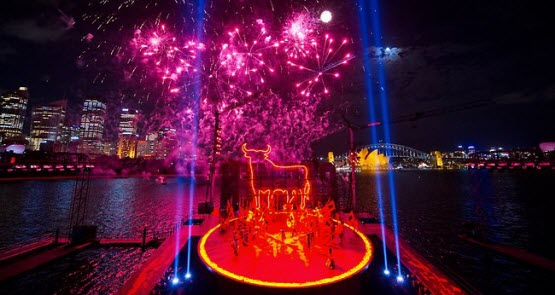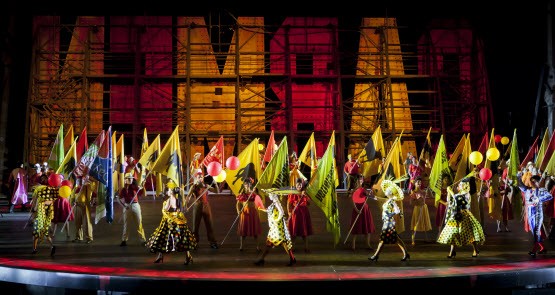
It’s the second year out for Opera Australia’s Handa Opera On Sydney Harbour and, I reckon, the best.
(Mind you, I still have a political perspective, if you will, that tends to distract from my aesthetic appreciation. If OA is sincere about bringing new audiences to opera, it has to find new ways to subsidise the cost of tickets. Yes, one can pay as little as $97 for a ticket to Carmen, but one can pay as much as $325. It’s not a problem that’s restricted to opera, of course. But the point remains. And you’ll pay $12-15 for a glass of wine when you get there. Yes, there’s Opera In The Domain, but not having, say, $50 tickets to a universally appealing opera such as Carmen is a lost opportunity to recruit genuinely new, engaged audiences to opera, rather than just well-heeled big-night-outers, such as the noisy ones sitting near me, who saw fit to toe-tap, sans rhythm and converse more-or-less all the way through the first act — after which they left.)
This is as good a production of Carmen as anyone could hope to mount in or outdoors, but especially out. Director Gale Edwards has a head on her shoulders. It’s patent she’s thought deeply and site-specifically about the challenges and necessities of staging. Her solution is to be big, bold and, above all, keep things moving. No one could credibly argue she’s done anything less than what is optimum; her take is as good as it gets.
Happily, Bizet’s busy narrative (libretto by Henri Meilhac and Ludovic Halevy, based on Prosper Merrimee’s novella) and urgent music, too, keeps things afoot, to begin with. The thing is, though, it’d be so much better indoors. Again, I risk being accused of conservatism, but the fact is, for all its grand spectacle, much is lost.
The problem is remoteness. Distance. Admittedly, my companion and I were seated off to the far side and not all that close to the front, but from what I can see moving around the site, no seats offer the kind of proximity that affords any appreciation of the finer theatrical skills of the performers. I couldn’t discern any facial expressions from my crow’s nest, so virtually all is left to body language. Again, Edwards has made the right decision, in keeping it pronounced and relying heavily on Kelley Abbey’s choreography, which is outstanding. Her interpolations of flamenco are fiery works of visual art as well as being as visceral as that form suggests. She’s even had the temerity to allow palmas to compete with the score itself, with conductor Brian Castles-Onion rightly uncomplaining, all seeming to embrace the work as a whole and collaborating to ensure openness to innovation in ways that honouring Bizet’s intention.
Julie Lynch’s costumes are fabulous: a diverse palette, dominated by rich reds, golds and scarlets, which shimmer and shimmy under John Rayment’s lights. Both lighting and sound design are much better than I remember them being last year for La traviata; Tony David Cray deserves particular mention for the voices came across with splendid clarity and excellent balance. No mean feat, given the situation.
The tone is set by nine-metre tall red letters spelling out Carmen, which even Mr Magoo could spot a mile off. These are oriented for outsiders to enviously read while we, the privileged, revel in the most famous opera of them all. And the above gripes aside, there’s still ample opportunity to be thrilled by this production. The redoubtable Australian Opera and Ballet Orchestra, tragically hidden from view (can’t this also be looked at?), is in vigorous form, despite being closer to Neptune’s basement than is usually the case. The members remain unfazed, no matter what’s thrown at them.

And the nub of it, the singing. I’m hard-pressed to recollect another occasion on which Opera Australia has recruited such a euphonious ensemble of singers. The chorus is in typically lusty voice as well. Israeli mezzo Rinat Shaham ought to be a world’s best-practice Carmen (she’s been performing the role for a lucky 13 years) and she most assuredly is. Despite the limitations of outdoor miking and amplification which, in my experience, tend to thin vocals considerably, Shaham couldn’t have sung with more colour, power, passion, depth or richness. She is stunning, from top to bottom of her considerable range; every note and nuance so utterly self-assured it borders on smug. Better yet, in all the other ways that Carmen needs to convince (as a powerful, man-eating woman and electrifyingly sexy gypsy goddess), Shaham comes across. Edwards ups the ante with a provocatively staged scene that borders on the explicit. My one reservation in seeing Shaham in the role is that I won’t get to see the other Carmen, Milijana Nikolic, who, on past performance, gives every indication of being just as rousing in all the above respects.
Shaham isn’t just in good company, but great. Ukrainian Dmytro Popov, as the pathetically naive soldier Don Jose, delivers a suitably pained performance, his glorious tenor showing how, and why, he was a prize-winner at Placido Domingo’s 2007 Operalia World Contest in Paris. Watch out, maestro. He mightn’t look very Spanish, but he certainly knows how to harness emotion with profound musicality.
Andrew Jones sung as handsomely as he presents as the glamorous toreador Escamillo, a man who embodies every traditional masculine virtue. Jones consolidates his reputation as one of our best and brightest baritones. This role could be just the springboard that catapults him to the international renown he, too, richly reserves. His tone was confident and full, befitting a hero. Nicole Car is (as a promising young soprano on the threshold, one senses and hopes, of a big breakthrough), in a way, his counterpart and counterpoint. Her Micaela is as fragile and vulnerable as one might hope for and her tone almost achingly beautiful; she is, as has been much and rightly attested already, another shooting star in OA’s stable.
There is much talent in the lesser roles as well. In a way, as uncomfortably close as it made the atmosphere, it was helpful Sydney turned on a humid, overcast evening for opening night. It made the bridge, Opera House and skyline less distracting than might otherwise have been the case (and was, last year). Fireworks were kept to a minimum and were more in keeping with the flavour of the work than with La traviata, too.
This is probably as good as Handa Opera on Sydney Harbour can get: a stunning array of exciting, young voices, already fully-fledged but with seasoning and complexity to anticipate. Edwards’ imaginative staging, adventurous yet mindful of what’s really important, is the bomb. But opera outdoors, on this scale, has its problems and they seem, at the site, almost insuperable. One solution to the problem of remoteness is to incorporate large screens into the infrastructure. To some, this may be sacrilege, but it’s already done in The Domain and something is needed to reconnect with the performers and endow at least the pretence of intimacy.
None of this is to say you can’t have a very fulfilling evening regardless. After all, its still Carmen. It’s simply to say it all works better in the Joan Sutherland Theatre across Farm Cove, not staring back at it in awe. It seems a shame Bizet can’t be there to see just how far his opera has come. He died just 36 performances into its first-ever season, so never knew it’s triumphs. What a legacy he’s left us.
The details: Carmen plays 12 more performances until April 14. Tickets (and information on access and wet weather policy) on the company website.







Crikey is committed to hosting lively discussions. Help us keep the conversation useful, interesting and welcoming. We aim to publish comments quickly in the interest of promoting robust conversation, but we’re a small team and we deploy filters to protect against legal risk. Occasionally your comment may be held up while we review, but we’re working as fast as we can to keep the conversation rolling.
The Crikey comment section is members-only content. Please subscribe to leave a comment.
The Crikey comment section is members-only content. Please login to leave a comment.